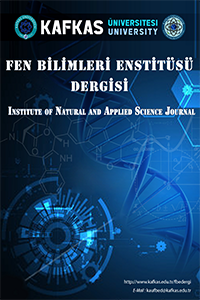Likenlerde Ağır Metal Alınma Mekanizmaları
Giderek sanayileşen dünyamızda, birçok canlıda olduğu gibi likenler de ağır metallere karşı savunmasız olduklarından yoğun biçimde ağır metallere maruz kalmaktadırlar. Bu çalışmanın amacı likenlerin ağır metallerin olumsuz etkilerine karşı nasıl tolerans oluşturduklarını, ağır metalleri kendi bünyelerine nasıl kattıklarını ve ağır metal alımı ile liken tallusu arasındaki ilişkileri incelemektir. Bu kapsamda likenlerin ağır metalleri nasıl biriktirdiğini ve liken metabolizmasının ağır metallere nasıl tepki verdiğini bilmek, biyoçeşitliliğin korunması için gereklidir. Ayrıca biyoizleme ve hatta biyojeokimyasal süreçlerin anlaşılması için de ipucu niteliğindedir. Yapılan biyoizleme çalışmalarının sonucu olarak liken tallusu içindeki ağır metal miktarı iklim, arazi örtüsü ve kirlilik kaynağına olan uzaklık ile ilişkilidir ve bu etmenler liken türlerinin dağılımını ve zenginliğini etkilemektedir. Likenler ağır metalleri absorblama yeteneklerinden dolayı çok iyi bir biyoindikatör özellik gösterirler. Likenlerin bu biyoindikatör özelliği şehir planlamasında, sanayi bölgelerinin oluşturulmasında, kirli alanların belirlenmesinde, atmosferik ağır metal kirliliğin tespitinde ve belirlenmesinde halk sağlığı için önemlidir.
Anahtar Kelimeler:
liken, ağır metal, biyoizleme, hava kirliliği
Heavy Metal Uptake Mechanisms in Lichens
In our increasingly industrialized world, like many living things, lichens are also vulnerable to heavy metals and are increasingly exposed to heavy metals. The aim of this study is to examine how lichens tolerate the negative effects of heavy metals, how they incorporate heavy metals into their body and the relationship between heavy metal uptake and lichen thallus. In this context, knowing how lichens accumulate heavy metals and how lichen metabolism responds to heavy metals is essential for biodiversity conservation and is a clue for biomonitoring and even understanding biogeochemical processes. As a result of the biomonitoring studies, the amount of heavy metals in the lichen thallus is related to the climate, land cover and distance to the pollution source, and these factors affect the distribution and richness of lichen species. Lichens show very good bioindicator properties due to their ability to absorb heavy metals. This bioindicator feature of lichens is important for public health in city planning, creation of industrial zones, determination of polluted areas, detection and determination of atmospheric heavy metal pollution.
Keywords:
Air pollution, Biomonitoring, Heavy metal, Lichen.,
___
- Agnan, Y., Probst A., Séjalon-Delmas, N. (2017) Evaluation of lichen species resistance to atmospheric metal pollution by coupling diversity and bioaccumulation approaches: a new bioindication scale for French forested areas. Ecol Indic,72, 99–110.
- Anderson, J., Levesque, N., Caron, F., Beckett, P., Spiers, G.A. (2022). A review on the use of lichens as a biomonitoring tool for environmental radioactivity. Journal of Environmental Radioactivity, 243, 106797.
- Aras, S., Beyaztaş, T., Cansaran-Duman, D. (2008). Likenlerde ağır metal birikiminin dna üzerindeki etkileri. Türk Bilimsel Derlemeler Dergisi, 1 (2), 37-43.
- Backor, M., Fahselt, D. (2008). Lichen photobionts and metal toxicity. Symbiosis, 46, 1-10. Brown, D.H., Beckett, R.P. (1984). Uptake and effect of cations on lichen metabolism. Lichenologist, 16(2), 173-188. Burtis, C. A., Ashwood, R. E. (2002). Fundamentals of clinical chemistry. 5th Edition, 652- 659. Çobanoğlu, G. (2015). The use of lichens for biomonitoring of atmospheric pollution. Sigma J Eng & Nat Sci, 33 (4), 591-613.
- Exposito, J.R., Barreno, E., Catala, M. (2020). Biological strategies of lichen symbionts to the toxicity of lead (Pb). Springer Nature Switzerland AG,149-170.
- Garty, J. (2001). Biomonitoring atmospheric heavy metals with lichens: theory and application. Critical Reviews in Plant Sciences, 20(4),309-371.
- Haas, J.R., Purvis, O.W. (2006). Lichen Biogeochemistry. Fungi in Biogeochemical Cycles (G.M. Gadd, ed.).Cambridge University, Cambridge, 344-376.
- Honegger, R. (1997). Metabolic interactions at the mycobiont-photobiont interface in lichens. In: The Mycota, Vol 5A, Plant Relationships, Part A. (G.C. Carroll and P. Tudzynski, eds.).Springer-Verlag, New York, 209-221.
- Hoodaji, M., Ataabadi, M., Najafi, P. (2012). Biomonitoring of airborne heavy metal contamination. Air Pollution – Monitoring, Modelling, Health and Control, 97-122.
- Purvis, O.W. (2000). Lichens. Life series. Natural History Museum, London, ISBN 0-565-09153-0. Purvis, O.W., Pawlik-Skowronska, B. (2008). Lichens and metals. British Mycological Society Symposia Series.27,175-200.
- Richardson, D.H.S. (1995). Metal uptake in lichens. Symbiosis, 18,119-127.
- Rola, K. (2020). Insight into the pattern of heavy-metal accumulation in lichen thalli. Journal of Trace Elements in Medicine and Biology, 61-126512.
- Sarrett, G., Manceau, A., Cuny, D., Van Haluwyn, C., Deruelle, S., Hazemann, J.L., Soldo, Y., Eybert-Berard, L. and Menthonnex, J.J. (1998). Mechanisms of lichen resistance to metallic pollution. Environmental Science and Technology, 32, 3325–3330.
- Yavuz, M. (2010). Gölcük Tabiat Parkı liken florası ve Isparta hava kirliliğinin likenlerle derecelendirilmesi. Doktora Tezi. Marmara Üniversitesi, Fen Bilimleri Enstitüsü. İstanbul.
- Yıldız, A., Aksoy, A., Tuğ, G.N., İşlek, C., Demirezen, D. (2008). Biomonitoring of heavy metals by Pseudevernia furfuracea (L.) Zopf in Ankara (Turkey). Journal of Atmospheric Chemistry, 60, 71-81.
- Yıldız, A., Aksoy, A., Akbulut, G., Demirezen, D., İşlek, C., Altuner, E.M., Duman, F. (2011). Correlation between chlorophyll degradation and the amount of heavy metals found in Pseudevernia furfuracea in Kayseri (Turkey). Ekoloji, 20, 78, 82-88.
- Yıldız, A., Vardar Ç., Aksoy A., Ünal E. (2018). Biomonitoring of heavy metals deposition with Pseudevernıa furfuracea (L.) Zopf in Çorum city, Turkey. Journal of Scientific Perspectives, January, 2(1), 9-22.
- ISSN: 2587-2389
- Yayın Aralığı: Yılda 2 Sayı
- Başlangıç: 2008
- Yayıncı: Kafkas Üniversitesi
Sayıdaki Diğer Makaleler
AAS ve Bulanık AAS Yöntemleri ve Bir Uygulama
Bağlantılı Liste Algoritmasını Kullanarak Çevrimiçi Öğrenme Ortamı Tasarlama
Optimization with Taguchi Method of Laser Parameters Necessary for Smooth Groove Bottom in ZAMAK 5
Analitik Fonksiyonların Belirli Bir Sınıfı İçin Fekete-Szegö Problemi Üzerine
